
Featured Breeder
Shinsaku Sakazume(Sakazume Koi Farm) |
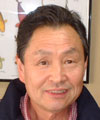 |
Mr. Sakazume, creator of “the Sakazume Aigoromo” which is highly appreciated from both national and international Koi lovers, places importance on his own sensitivity and continues producing Aigoromo that win high-ranking prizes at national Koi shows. He currently focuses on producing Aigoromo, Budo Goromo, and Sumi Goromo which are gaining popularity worldwide nowadays. He also produces Kohaku, Showa, and Yamato Nishiki.
|
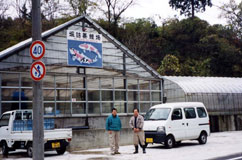 Sakazume Koi Farm was founded by Sakutaro, the predecessor of Shinsaku, in 1914 which was when Koi farms started forming in the area of Yamakoshi. Sakutaro mainly produced Kohaku after having established the brand “Sakubei Kohaku,” which was of the Yagozen Kohaku lineage from the Yamakoshi area and which had an astonishingly red hi. At the time, Nishikigoi had a presence in the community. I used to go feed the Koi in the mountain ponds after school in my elementary and junior high school years. In 1972 when I was 25, I got fully involved in Koi production after having worked outside my home. I started working at Sakazume Koi Farm without being trained anywhere and have done so up until now, so the foundation of my views towards Nishikigoi is that of my predecessor: “watch your Koi and care for them.” They taught me to go to the ponds to check on them at the first light of dawn, and that is something I still do. I believe Nishikigoi production should be at one with nature, so we should work together with it. Sakazume Koi Farm was founded by Sakutaro, the predecessor of Shinsaku, in 1914 which was when Koi farms started forming in the area of Yamakoshi. Sakutaro mainly produced Kohaku after having established the brand “Sakubei Kohaku,” which was of the Yagozen Kohaku lineage from the Yamakoshi area and which had an astonishingly red hi. At the time, Nishikigoi had a presence in the community. I used to go feed the Koi in the mountain ponds after school in my elementary and junior high school years. In 1972 when I was 25, I got fully involved in Koi production after having worked outside my home. I started working at Sakazume Koi Farm without being trained anywhere and have done so up until now, so the foundation of my views towards Nishikigoi is that of my predecessor: “watch your Koi and care for them.” They taught me to go to the ponds to check on them at the first light of dawn, and that is something I still do. I believe Nishikigoi production should be at one with nature, so we should work together with it.
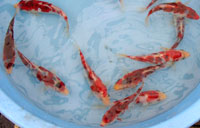 Currently at Sakazume Koi Farm, we produce Koromo, Kohaku, Showa, and Yamato Nishiki. Half of the production is Koromo, and half of Koromo is the booming Budo Goromo. I started producing Koromo in 1991. When I saw the Aigoromo that won the Category Champion at the All Japan Nishikigoi Show held by Zen Nippon Airinkai in Niigata in 1990, I sensed that it was “a Koi to be used as oyagoi, not to vie in beauty.” I negotiated with the owner if I could use it as my oyagaoi, and that’s how our Aigoromo got started. The Koi’s patterns were not so good. But it had pure beautiful shiroji, fascinating ai (indigo blue) sashi (the blurry line between the front of a Hi plate or Sumi and the Shiroji), ai on body wide hi, and “outstanding potential as an oyagoi.” We don’t have that oyagoi anymore, but its genealogy still lives. To me, the interesting part of Nishikigoi production is producing Nishikigoi based on one’s sensitivity. That is why when Koi lovers become fond of my Aigoromo which are produced based on my sensitivity by trusting my own instincts, it is very rewarding. Currently at Sakazume Koi Farm, we produce Koromo, Kohaku, Showa, and Yamato Nishiki. Half of the production is Koromo, and half of Koromo is the booming Budo Goromo. I started producing Koromo in 1991. When I saw the Aigoromo that won the Category Champion at the All Japan Nishikigoi Show held by Zen Nippon Airinkai in Niigata in 1990, I sensed that it was “a Koi to be used as oyagoi, not to vie in beauty.” I negotiated with the owner if I could use it as my oyagaoi, and that’s how our Aigoromo got started. The Koi’s patterns were not so good. But it had pure beautiful shiroji, fascinating ai (indigo blue) sashi (the blurry line between the front of a Hi plate or Sumi and the Shiroji), ai on body wide hi, and “outstanding potential as an oyagoi.” We don’t have that oyagoi anymore, but its genealogy still lives. To me, the interesting part of Nishikigoi production is producing Nishikigoi based on one’s sensitivity. That is why when Koi lovers become fond of my Aigoromo which are produced based on my sensitivity by trusting my own instincts, it is very rewarding.
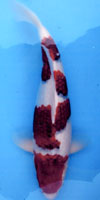 When viewing Aigoromo, you should look at the color of the ai. The ideal Aigoromo should have fine ai color along hi scales and sashi with beautiful ai. It would be even better if there is koromo on all hi, and if the koromo is a mesh design, not blocked together. The most important thing in Aigoromo is the color of ai, not the patterns. When selecting the parent, we place emphasis on the ai because its quality is inheritable just like hi. The koromo has to be present to be called one. When viewing Aigoromo, you should look at the color of the ai. The ideal Aigoromo should have fine ai color along hi scales and sashi with beautiful ai. It would be even better if there is koromo on all hi, and if the koromo is a mesh design, not blocked together. The most important thing in Aigoromo is the color of ai, not the patterns. When selecting the parent, we place emphasis on the ai because its quality is inheritable just like hi. The koromo has to be present to be called one.
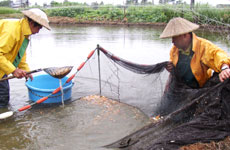 The characteristics of the Sakazume Aigoromo is that, compared to others, it has good patterns and body conformation. Our Aigoromo had excellent koromo at the beginning: koromo that appeared in sandan and yondan patterns. The koromo of our Koi not only has great shapes, but it also appears at an early stage, which is another remarkable feature. You can start raising our Aigoromo from the tosai stage because that is when koromo appears. It is often said that a tosai with ai will grow to be black, but ours don’t. Our Koromo can grow to be more than 80 cm (32 inches) in length if you raise it well. People say it is difficult for Koromo to have desirable body conformation, but our oyagoi are 80 cm long, which means that if you raise them in favorable environment, the body conformation may become good. The characteristics of the Sakazume Aigoromo is that, compared to others, it has good patterns and body conformation. Our Aigoromo had excellent koromo at the beginning: koromo that appeared in sandan and yondan patterns. The koromo of our Koi not only has great shapes, but it also appears at an early stage, which is another remarkable feature. You can start raising our Aigoromo from the tosai stage because that is when koromo appears. It is often said that a tosai with ai will grow to be black, but ours don’t. Our Koromo can grow to be more than 80 cm (32 inches) in length if you raise it well. People say it is difficult for Koromo to have desirable body conformation, but our oyagoi are 80 cm long, which means that if you raise them in favorable environment, the body conformation may become good.
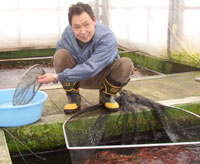 My goal is to produce Koi that would please the customers, not Aigoromo that would win championships or Kokugyo prizes at Koi shows. It is encouraging to hear people around the world say “Mr. Sakazume’s Koi are beautiful,” or “Mr. Sakazume’s Aigoromo has improved,” or “Mr. Sakazume’s Koi won a prize at a show.” When I produce Koi based on my sensitivity, and they are loved be Koi lovers, it makes all the effort worthwhile. My goal is to produce Koi that would please the customers, not Aigoromo that would win championships or Kokugyo prizes at Koi shows. It is encouraging to hear people around the world say “Mr. Sakazume’s Koi are beautiful,” or “Mr. Sakazume’s Aigoromo has improved,” or “Mr. Sakazume’s Koi won a prize at a show.” When I produce Koi based on my sensitivity, and they are loved be Koi lovers, it makes all the effort worthwhile.
I believe there isn’t much for me to say because worldwide Koi lovers know very well about Nishikigoi. But one thing I would like to request as an Aigoromo producer is for you to not only learn about it but to actually raise one. You normally wouldn’t keep a number of Aigoromo in your own pond, but one would make a big presence in the pond. Aigoromo is a very fine Koi, so I hope you have the chance to enjoy raising one.
|
|

 Sakazume Koi Farm was founded by Sakutaro, the predecessor of Shinsaku, in 1914 which was when Koi farms started forming in the area of Yamakoshi. Sakutaro mainly produced Kohaku after having established the brand “Sakubei Kohaku,” which was of the Yagozen Kohaku lineage from the Yamakoshi area and which had an astonishingly red hi. At the time, Nishikigoi had a presence in the community. I used to go feed the Koi in the mountain ponds after school in my elementary and junior high school years. In 1972 when I was 25, I got fully involved in Koi production after having worked outside my home. I started working at Sakazume Koi Farm without being trained anywhere and have done so up until now, so the foundation of my views towards Nishikigoi is that of my predecessor: “watch your Koi and care for them.” They taught me to go to the ponds to check on them at the first light of dawn, and that is something I still do. I believe Nishikigoi production should be at one with nature, so we should work together with it.
Sakazume Koi Farm was founded by Sakutaro, the predecessor of Shinsaku, in 1914 which was when Koi farms started forming in the area of Yamakoshi. Sakutaro mainly produced Kohaku after having established the brand “Sakubei Kohaku,” which was of the Yagozen Kohaku lineage from the Yamakoshi area and which had an astonishingly red hi. At the time, Nishikigoi had a presence in the community. I used to go feed the Koi in the mountain ponds after school in my elementary and junior high school years. In 1972 when I was 25, I got fully involved in Koi production after having worked outside my home. I started working at Sakazume Koi Farm without being trained anywhere and have done so up until now, so the foundation of my views towards Nishikigoi is that of my predecessor: “watch your Koi and care for them.” They taught me to go to the ponds to check on them at the first light of dawn, and that is something I still do. I believe Nishikigoi production should be at one with nature, so we should work together with it.





